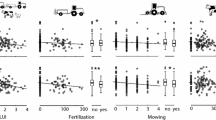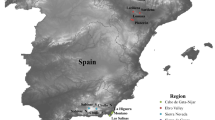Summary
An intensive sample of Australian mallee included a strip of 100 1 sq. m plots and counts of species numbers in expanding areas (1, 10, 100, and 1000 sq. m) to a full hectare. Reciprocal averaging (RA) produced an effective arrangement of the sq. m plots and their species along an axis of internal pattern from mallee patches to the openings between them. RA scores permitted definition of the patches and transitions and comparisons of relative difference between successive sq. m plots (mean RA score differences of 6.9 in the openings, 11.9 in mallee patches, and 14.7 in transitions). Pattern diversity, measured as degree of species turnover along the first RA axis, was 2.3 half-changes. Groups of species most characteristic of openings, transitions, and mallee patches could be recognized; but many species are of wide amplitude along the pattern axis, and neither RA nor association measurements showed distinct species groups separate from one another. The mallee sample is rich in species (mean of 53/0.1 ha, total of 101/ha) compared with North American samples; it is roughly similar to North American woodlands and shrublands in life-form spectrum but different in growth-form representation. Mean heights of species formed an apparent lognormal distribution with the concentration of species in the 0.2–0.4 m oetave. Species numbers in relation to areas (A, in sq. m), traced from 1 sq. mm to 105 sq. m, were reasonably fitted by either S=5.33 + 15.28 log A or S=8.22A 0.29 at intermediate quadrat sizes (1–1000 sq. m) but not at smaller sizes. The ten replicate 0.1 ha samples gave coefficients of variation of 7% for species numbers and 9–10% for the regression coefficients (except b=5.33 with a CV of 43%).
Similar content being viewed by others
References
BeadleN.C.W. 1948. The Vegetation and Pastures of Western New South Wales, with Special Reference to Soil Erosion. Tennant, Govt. Printer, Sidney. 281 pp.
Burrows, W.H. 1976. Aspects of nutrient cycling in semi arid mallee and mulga communities. Ph.D. Thesis, Australian National University, Canberra.
CodyM.L., 1975. Towards a theory of continental species diversities: bird distributions over Mediterranean habitat gradients. In: M.L.Cody & J.M.Diamond (eds.), Ecology and Evolution of Communities, pp. 214–257. Harvard Univ. Press, Cambridge.
ColeL.C. 1949. The Measurement of interspecific association. Ecology 30: 411–424.
DoingH. 1970. Botanical geography and chorology in Australia. Misc. Papers Landbouwhogeschool Wageningen 6: 81–98.
DoingH. 1971. Vegetation formations in Australia. Acta Bot. Neerl. 20: 258–259.
GauchH.G.Jr., R.H.Whittaker & T.R.Wentworth. 1977. A comparative study of reciprocal averaging and other ordination techniques. J. Ecol. 65: 157–174.
GillA.M. 1975. Fire and the Australian flora: a review. Austral. forestry 38: 4–25.
Glenn-LewinD.C. 1977. Species diversity in North American temperate forests. Vegetatio 33: 153–162.
GoodallD.W. 1954. Objective methods for the elassification of vegetation. III. An essay in the use of factor analysis. Austral. J. Bot. 2: 304–324.
GoodallD.W. 1973. Sample similarity and species correlation. In: R.H.Whittaker (ed.), Ordination and Classification of Communities. Handb. Veget. Sci. 5: 105–156. Junk, The Hague.
Greig-SmithP. 1964. Quantitative Plant Ecology. Butterworths, London. 256 pp. 2nd ed.
HarnerR.F. & K.T.Harper. 1976. The role of area, heterogencity, and favorability in plant species diversity of pinyonjuniper ecosystems. Ecology 57: 1254–1263.
HillM.O. 1973a. The intensity of spatial pattern in plant communities, J. Ecol. 61: 225–235.
HillM.O. 1973b. Reciprocal averaging: an eigenvector method of ordination. J. Ecol. 61: 237–249.
HillM.O. 1974. Correspondence analysis: a neglected multivariate method. J. Roy. Stat. Soc., Ser. C, 23: 340–354.
JonesE.W. 1955–6. Ecological studies on the rain forest of southern Nigeria. IV. The plateau forest of the Okomu Forest Reserve. J. Ecol. 43: 564–594, 44: 83–117.
KershawK.A. 1957. The use of cover and frequency in the detection of pattern in plant communities. Ecology 38: 291–299.
Krishna IyerP.V. 1948. The theory of probability distribution of points on a line. J. Indian Soc. Agric. Statist. 1: 173–195.
MaarelE.van der & J.Leertouwer. 1967. Variation in vegetation and species diversity along a local environmental gradient. Acta Bot. Neerl. 16: 211–221.
MacArthurR.H. & E.O.Wilson. 1967. The Theory of Island Biogeography. Princeton Univ. Press, Princeton, N.J. 203 pp.
MarksP.L. & P.A.Harcombe. 1975. Community diversity of coastal plain forests in southern east Texas. Ecology 56: 1004–1008.
MayR.M. 1975. Patterns of species abundance and diversity. In: M.L.Cody & J.M.Diamond (eds.), Ecology and Evolution of Communities. pp. 81–120. Harvard Univ. Press, Cambridge.
MoralR.del. 1972. Diversity patterns in forest vegetation of the Wenatchee Mountains, Washington. Bull. Torrey Bot. Club. 99: 57–64.
Noy-MeirI. 1971. Multivariate analysis of the semi-arid vegetation in southeastern Australia: nodal ordination by component analysis. Proc. Ecol. Soc. Austral. 6: 159–193.
Noy-MeirI. 1974. Multivariate analysis of the semiarid vegetation in south-eastern Australia. II. Vegetation catenae and environmental gradients. Aust. J. Bot. 22: 115–140.
PeetR.K. 1978. Forest vegetation of the Colorado Front Range: patterns of species diversity. Vegetatio 37: 65–78.
PielouE.C. 1966. Species-diversity and pattern-diversity in the study of ecological succession. J. Theoret. Biol. 10: 370–383.
PielouE.C. 1974. Population and Community Ecology: Principles and Methods. Gordon & Breach, New York. 424 pp.
SchimperA.F.W. 1903. Plant-Geography upon a Physiological Basis. Clarendon, Oxford. 839 pp.
SchmithüsenJ. 1968. Allgemeine Vegetationsgeographie. 3rd ed. de Gruyter, Berlin. 463 pp.
SpechtR.L. 1966. The growth and distribution of malleebroombush (Eucalyptus incrassata-Melaleuca uncinata association) and heath vegetation near Dark Island Soak, Ninety-Mile Plain, South Australia. Aust. J. Bot. 14: 361–371.
WalterH. 1968. Die Vegetation der Erde in öko-physiologischer Betrachtung. Vol. II: Die gemässigten und arktischen Zonen. Fischer, Jena. 1001 pp.
WhittakerR.H. 1960. Vegetation of the Siskiyou Mountains, Oregon and California. Ecol. Monogr. 30: 279–338.
WhittakerR.H. 1965. Dominance and diversity in land plant communities. Science 147: 250–260.
WhittakerR.H. 1972. Evolution and measurement of species diversity. Taxon 21: 213–251.
WhittakerR.H. 1977. Evolution of species diversity in land communities. Evol. Biol. 10: 1–67.
WhittakerR.H. & C.W.Fairbanks. 1958. A study of plankton copepod communities in the Columbia Basin, southeastern Washington. Ecology 39: 46–65.
WhittakerR.H. & W.A.Niering. 1964. Vegetation of the Santa Catalina Mountains, Arizona. I. Ecological classification and distribution of species. J. Ariz. Acad. Sci. 3: 9–34.
WhittakerR.H. & W.A.Niering. 1965. Vegetation of the Santa Catalina Mountains, Arizona. (II) A gradient analysis of the south slope. Ecology 46: 429–452.
WoodJ.G. 1929. Foristics and ecology of the mallee. Trans. R. Soc. S. Aust. 53: 359–378.
WoodJ.g. 1937. The Vegetation of South Australia. Adelaide, Trigg, Govt: Printer. 164 pp.
Author information
Authors and Affiliations
Additional information
We thank R.O. Slatyer and the Department of Environmental Biology, Australian National University, Canberra, and A.B. Court and the Canberra Botanic Gardens for generous assistance that made the field work in Australia possible, W.H. Burrows for help in the field and supporting information, H.G. Gauch, Jr. for assistance with computations, and M.O. Hill, P.L. Marks and O. Sholes for comments on the manuscript. The work was supported by grants from the Australian National University and the U.S. National Science Foundation.
Rights and permissions
About this article
Cite this article
Whittaker, R.H., Niering, W.A. & Crisp, M.D. Structure, pattern, and diversity of a mallee community in New South Wales. Vegetatio 39, 65–76 (1979). https://doi.org/10.1007/BF00052018
Accepted:
Published:
Issue Date:
DOI: https://doi.org/10.1007/BF00052018




